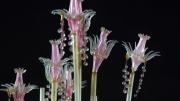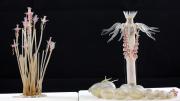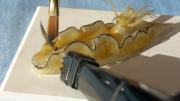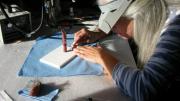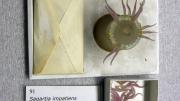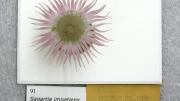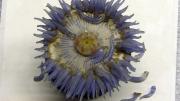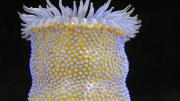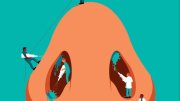Legend has it that on an ocean voyage to the United States in 1853, Bohemian glassmaker Leopold Blaschka began making drawings of animals the crew fished out of the sea. The nineteenth century was a time of naturalistic exploration: expeditions traveled to far-flung parts of the world and returned with specimens of exotic creatures, to widespread public interest. For Blaschka, the sea voyage began a lifelong obsession. Upon returning home, he turned away from the family tradition of making glass eyes and jewelry and instead began crafting marine invertebrates—jellyfish, squid, sea slugs—all painstakingly and faithfully rendered in glass.
Decades before Harvard commissioned them to create its famous Glass Flowers, Leopold and his son, Rudolf, became known for their invertebrate models, which were acquired by museums and universities across the world. Now a new permanent exhibit at the Harvard Museum of Natural History, Sea Creatures in Glass, showcases more than 50 examples of the Blaschkas’ earlier work, drawn from a collection of 430 models owned by the Museum of Comparative Zoology (MCZ).
The exhibit marks a milestone in the models’ restoration; the work will be completed thanks to a gift in memory of Melvin R. Seiden ’52, LL.B. ’55, that also paid for exhibit installation costs. (MCZ discretionary funds have paid for the restoration to date.) “Some breakage has happened over time, though we’re very lucky that it’s minimal,” says Linda S. Ford, director of collections operations at the MCZ, who oversees the restoration. “The biggest problem was the glue failure.” In the more than 120 years since the models were produced, the animal-hide glue used in their construction was beginning to deteriorate, causing some pieces to fall off. “It’s like a giant jigsaw puzzle,” says glass artist Elizabeth Brill in the video about the restoration process that complements the exhibit. For eight years, she cleaned and reassembled the aging models using reversible archival glue, reuniting octopuses with their suction cups and anemones with their tentacles.
In doing so, Brill and the museum staff were able to figure out some of the Blaschkas’ methods. The two men worked differently, and their techniques evolved across the decades. The invertebrate models, made mostly of clear glass, took their patterns and colors from paint, but for the later botanical models, the Blaschkas began making their own colored glass. They also used two different types of glass, with different melting points; this allowed one piece to be welded to another without both losing their shapes. The father-and-son team often made many parts at once—tentacles, for instance—and assembled the finished models to order; wire, animal hide, and paper bestowed structure and form. In Ward’s Catalogue of 1878, the glass invertebrates—arranged taxonomically and listed by scientific name—sold for a few dollars apiece. Some were available for as little as 25 cents (approximately six dollars today).
“In an age before video and film photography, these models were the nature documentaries of their day,” says James Hanken, Agassiz professor of zoology and director of the MCZ. “This is how people learned about natural history.” The glass models were especially important for studying marine invertebrates; when preserved in spirits, the sea creatures swiftly lost their color and form. In building their specimens, the Blaschkas combined their own observations with those of published zoological accounts, and the models, intended as teaching tools, are full of naturalistic detail. Some show the same organism at different life stages, while others render key features larger than life. “All the animals mentioned in this catalogue, are represented exactly according to their natural form and color,” wrote the elder Blaschka in Ward’s Catalogue. “They are universally acknowledged as being perfectly true to nature.”
MCZ founder Louis Agassiz and his son, Alexander, themselves marine enthusiasts, acquired many invertebrate models for Harvard’s collection, as did the Boston Society of Natural History for what is now the Museum of Science. There, the models caught the eye of botanist George Lincoln Goodale, director of the Harvard Botanical Garden and Museum, who struck up a correspondence with the Blaschkas and traveled to their home, near Dresden, to persuade them to prepare a collection of plant models. The first samples shattered during their transatlantic voyage, but the fragments nevertheless earned the admiration and support of the wife and daughter of Charles Eliot Ware, A.B. 1834, Elizabeth C. and Mary Lee Ware, who financed the collection in his memory. The Blaschkas’ exclusive contract with Harvard, which began in 1887 and extended through the ends of both men’s lives, yielded some 4,300 models, from 847 plant families.
“Within a few weeks of [the Glass Flowers’] installation the attendance at the museum greatly increased and at times was more than doubled,” notes a biography of Goodale. Today, the flowers—and now, the glass sea creatures—continue to draw a crowd. As Brill says in the new exhibit’s video, “These things are still doing what they were made to do.”
For more on the glass invertebrates, see “The Glass Animals.” For more artistic accounts of natural history, see “Blake’s Whales,” an exhibit of drawings from the 1871-1872 Hassler expedition, led by Louis Agassiz.
